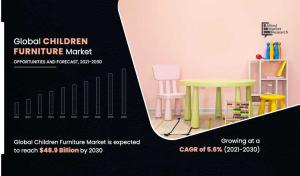Children Furniture Market Estimated at $48.9 Billion by 2030, Registers Steady 5.6% CAGR From 2021-2030
Children furniture market size was valued at $26.6 billion in 2020, is projected reach $48.9 billion by 2030, registering a CAGR of 5.6% from 2021 to 2030.
Request Sample Copy of Report: https://www.alliedmarketresearch.com/request-sample/14080
Surge in expenditure on children-associated products and increase in advertising through social media and digital marketing drive the growth of the global children furniture market. However, rise in raw material prices and negative impact on the environment are the factors that hinder the market growth. On the other hand, increase in online shopping and usage of 3D printers present new opportunities in the coming years.
Increase in population density in metro cities has been majorly driving the growth of the children furniture industry. People are majorly migrating from rural areas to metro cities in search of job opportunities and are bringing their families along with them. About 55% of the global population was living in urban areas in 2018; however, this number is expected to surpass 68% by the end of 2050. This migration creates potential opportunities for real estate, hotels & restaurants, hospitals, and clinics, where various types of furniture, including children furniture products are required, thus increasing the demand for children furniture. Rise in urbanized population is creating huge demand for children furniture, thus driving children furniture market growth.
Based on type, the beds, cots & cribs segment accounted for the largest share in 2020, holding more than two-fifths of the total share, and is estimated to continue its leadership status throughout the forecast period. However, the cabinet, dressers & chests segment is projected to manifest the highest CAGR of 7.0% from 2021 to 2030.
Based on sales channel, the offline channels segment contributed to the highest share in 2020, accounting for more than four-fifths of the global children furniture market, and is estimated to maintain its lead position throughout the forecast period. However, the online channels segment is expected to register the fastest CAGR of 6.3% from 2021 to 2030.
Based on region, North America held the highest market share in 2020, contributing to nearly two-fifths of the total share, and is expected to continue its lead in terms of revenue by 2030. However, Asia-Pacific is estimated to portray the largest CAGR of 8.5% during the forecast period.
Leading players of the global children furniture market analyzed in the research include Cello Group, Herman Miller, Cosmoplast Industrial Company LLC, Keter Group, Sleep Number Corporation, Inter IKEA Systems B.V., Pil Italica, Nilkamal Limited, Sauder Woodworking Company, Lifestyle, and Tramontina.
LIMITED-TIME OFFER - Buy Now & Get Exclusive Discount on this Report: https://www.alliedmarketresearch.com/checkout-final/ab7a2336dbb61c7d5e26b68f9367a5df
NewSky Security Expands into Cyber Security Private Investigations to Combat Sophisticated Botnet and VPN Threats
CTO G. Vimal Kumar of Cyber Privilege Honored for Advancing Cyber Forensics and Digital Evidence in India
Breaking Barriers: Puerto Rican Chess Enthusiast Alex Martinez Makes History at Serbian Chess Open
Kalendarium
Więcej ważnych informacji
 Jedynka Newserii
Jedynka Newserii

 Jedynka Newserii
Jedynka Newserii

Prawo

KE proponuje nowy Fundusz Konkurencyjności. Ma pobudzić inwestycje w strategiczne dla Europy technologie
W środę 16 lipca Komisja Europejska przedstawiła projekt budżetu na lata 2028–2034. Jedna z propozycji zakłada utworzenie Europejskiego Funduszu Konkurencyjności o wartości ponad 400 mld euro, który ma pobudzić inwestycje w technologie strategiczne dla jednolitego rynku. Wśród wspieranych obszarów znalazła się obronność i przestrzeń kosmiczna. Na ten cel ma trafić ponad 130 mld euro, pięciokrotnie więcej niż do tej pory.
Firma
Były prezes PGE: OZE potrzebuje wsparcia magazynów energii. To temat traktowany po macoszemu

Choć udział odnawialnych źródeł energii w miksie energetycznym Polski jest stosunkowo wysoki i rośnie, to ten przyrost jest chaotyczny i nierównomiernie rozłożony miedzy technologiami – wskazuje Forum Energii. Dodatkowo OZE potrzebują wsparcia magazynów energii, a zdaniem Wojciecha Dąbrowskiego, prezesa Fundacji SET, ten temat jest traktowany po macoszemu. Brak magazynów powoduje, że produkcja energii z OZE jest tymczasowo wyłączana, co oznacza marnowanie potencjału tych źródeł.
Infrastruktura
Wzrost wynagrodzeń ekip budowlanych najmocniej wpływa na koszty budowy domu. Zainteresowanie inwestorów mimo to nieznacznie wzrasta

Budowa metra kwadratowego domu w Polsce kosztuje od 5,55 do 6 tys. zł w zależności od województwa – wynika z najnowszych analiz firmy Sekocenbud. Najdrożej jest w Warszawie, gdzie cena za metr kwadratowy domu przekroczyła już 6,2 tys. zł. Na przyrosty kosztów budowy domu wpływają zarówno drożejące materiały budowlane, jak i wyższe wynagrodzenia pracowników. Inwestorzy nie rezygnują jednak z budowy domów jednorodzinnych, co ma związek m.in. z wciąż wysokimi cenami mieszkań czy też obniżką stóp procentowych.
Partner serwisu
Szkolenia

Akademia Newserii
Akademia Newserii to projekt, w ramach którego najlepsi polscy dziennikarze biznesowi, giełdowi oraz lifestylowi, a także szkoleniowcy z wieloletnim doświadczeniem dzielą się swoją wiedzą nt. pracy z mediami.









.gif)

 |
| |
| |
|